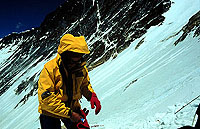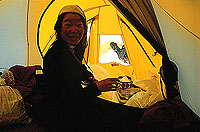 |
 |
 |
 Assault on the Summit
Assault on the Summitpart 6 | back to part 5 Other Physiological Effects of Altitude The oxygen-starved atmosphere on Everest makes itself known through fatigue, loss of appetite, headaches, dehydration, and even loss of muscle tissue—especially at the higher camps. Araceli comments on what she expects on the last part of the climb: "From the South Col to the summit, that's the most difficult part. Because there's less oxygen and you are more tired. You have been a lot of time climbing and that makes your body be, how do you say?.... You lose energy. And all this time at high altitude you are losing energy. You will lose muscle and all the power and you must be prepared not only physically but psychologically." At altitudes of over 21,000 feet, muscle tissue may deteriorate and resistence to cold is greatly reduced. Eating and sleeping patterns are severely altered. Climbers force themselves to eat and drink and then crawl into their sleeping bags. At Camp 4, breathing supplemental oxygen at night can allow a climber to get high quality sleep.  On arrival at altitude, almost immediately the heart beats faster and more
forcefully, and the volume and frequency of breathing increases. Water is
exhaled with each breath and dehydration becomes another concern. Each climber
drinks 4-6 quarts of fluid per day. Wind can further dehydrate the climbers
and the wind chill factor can drop to temperatures as low as -120 degrees.
Dehydration, in advanced stages, can cause blood to thicken, increasing the
risk of two of the most common medical ailments at altitude: frostbite and fatigue. On the summit, just warming and moisturizing
the cold dry air that the climbers will breathe will take so much of their
metabolic energy that they cannot stay warm there for more than a short time,
no matter what they wear. In order to compensate for the lack of oxygen, the
red corpuscles multiply to such an extent that the blood becomes even thicker and
does not circulate as freely, especially in the small capillaries of the
extremities. This increases the risk of frostbite.
On arrival at altitude, almost immediately the heart beats faster and more
forcefully, and the volume and frequency of breathing increases. Water is
exhaled with each breath and dehydration becomes another concern. Each climber
drinks 4-6 quarts of fluid per day. Wind can further dehydrate the climbers
and the wind chill factor can drop to temperatures as low as -120 degrees.
Dehydration, in advanced stages, can cause blood to thicken, increasing the
risk of two of the most common medical ailments at altitude: frostbite and fatigue. On the summit, just warming and moisturizing
the cold dry air that the climbers will breathe will take so much of their
metabolic energy that they cannot stay warm there for more than a short time,
no matter what they wear. In order to compensate for the lack of oxygen, the
red corpuscles multiply to such an extent that the blood becomes even thicker and
does not circulate as freely, especially in the small capillaries of the
extremities. This increases the risk of frostbite.Continue Photos: (1-2) courtesy Robert Schauer. Lost on Everest | High Exposure | Climb | History & Culture | Earth, Wind, & Ice E-mail | Previous Expeditions | Resources | Site Map | Everest Home Editor's Picks | Previous Sites | Join Us/E-mail | TV/Web Schedule About NOVA | Teachers | Site Map | Shop | Jobs | Search | To print PBS Online | NOVA Online | WGBH © | Updated November 2000 |